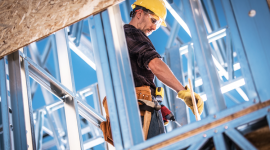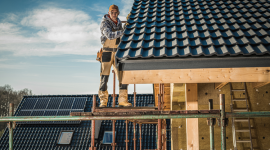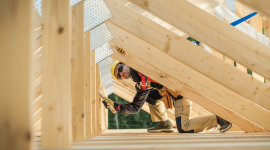If your business has a flat or low-slope roof, summer in Albuquerque can feel like a slow grind on your building’s shell. The sun shines hard for long stretches, and surfaces up there take the full hit. Unlike shingled residential roofs that sometimes get breaks thanks to angled shade, commercial roofs often sit fully exposed. That direct hit from sunlight and summer heat doesn’t just make the roof hot, it starts to eat away at whatever materials are up there. Some changes might happen slow and silently, but damage builds up over time.
UV rays and high temperatures can cause major trouble without much warning. Even newer roofs deal with drying, cracking, and fading just from soaking in too much sun. Add in the stress of temperature swings between day and night, and your roof starts expanding and contracting like a rubber band. Eventually, something gives. If no one checks it in time, you may end up with leaks, sagging spots, or even structural issues. Albuquerque’s hot, dry climate doesn’t play nice with roofs that aren’t built or maintained to handle it.
Understanding UV Damage On Commercial Roofs
Sunlight can be brutal, especially at high elevations like Albuquerque. Roofs don’t just get warm, they bake. And when UV rays hit roofing material day after day, something’s going to give. Over time, that constant exposure breaks down protective layers. You may not notice anything right away, but the signs eventually surface.
The impact of UV rays changes depending on the material your roof’s made from:
– Rubber or EPDM roofs can dry out and form hairline cracks. Once cracks show, water can sneak in during occasional rain, even if those rains are short.
– TPO and PVC roofs might start fading or becoming brittle. These plastics shrink or curl when exposed for long stretches, especially without proper insulation underneath.
– Traditional modified bitumen can blister under the heat, and the adhesive bonding the layers starts to weaken.
– Spray foam roofing can yellow or chalk up as the top layer breaks down, losing its reflective ability.
Common signs of UV damage include:
– Color fading or yellowing
– Brittle or flaking surfaces
– Small cracks in the membrane
– Soft spots when walked on
– A chalk-like film on your hands after touching the roof
One business owner we worked with had a white TPO roof that looked perfectly fine from the ground. But during inspection, we spotted multiple seams pulling apart with light cracking near the AC units. UV rays had worked their way into those weak points, making the material brittle and ready to tear. If that goes unchecked, it doesn’t take much—just one windy afternoon or sudden downpour—to make it worse.
Early-stage damage might look cosmetic, but left alone, it opens doors to leaks, roof deck rot, and trapped moisture under the membrane. That’s why noticing the small stuff really matters when it comes to keeping your roof in good shape for the long run.
The Effects Of Heat On Commercial Roofs
Heat isn’t just a problem when it spikes one afternoon. The real stress comes from repeat exposure, day after day, with little time for the roof to recover. Albuquerque’s long, dry summers mean that surfaces stay cooked for hours from late morning until well after sunset. That heat works its way into roofing systems and starts breaking them down from the outside in, and sometimes from the inside out.
When a roof gets repeatedly hot, the materials begin to do what most things do in extreme temperatures: they stretch. Then when it starts to cool at night, they shrink again. This movement, called thermal expansion and contraction, wears materials out like bending a wire back and forth until it snaps. Fasteners loosen up. Seams start to roll or shift. Before long, those once-tight parts open just enough for moisture to slip in when weather finally changes.
Here are a few common heat-related problems we’ve come across:
1. Membrane curling or wrinkling near the edges
2. Flashing speeds up wear if it’s metal, as it expands at different rates than synthetic materials
3. Blistering, where trapped air or moisture swells under heat and pushes material upward
4. Uneven surfaces can form soft or spongy spots where insulation has degraded
5. Roof penetrations like skylights or vent boots pulling away from the surface
When you step onto a commercial roof in late August, the difference between shaded areas and exposed spots is like night and day. Roofing that’s been overexposed might feel soft or warped underfoot because it simply doesn’t hold tension the way it should.
These problems don’t appear overnight, which makes them easy to miss if no one checks regularly. It’s not just about the sun being hot. It’s about slow, grinding damage that makes your roof more likely to fail when something unexpected hits, like a sudden rain after five straight weeks of dry heat. That’s the kind of vulnerability that costs way more to fix later if it gets ignored now.
Heat is inevitable, especially around Albuquerque. But identifying the signs of heat wear early gives you a way to stay ahead of it before it starts causing serious damage inside your building.
Preventive Measures For Protecting Commercial Roofs
The best way to deal with UV damage and heat stress on commercial roofs in Albuquerque is to stop it before it starts. Once the surface begins to break down, repairs usually cost more and take longer. A few smart steps can help extend your roof’s life and keep it performing under high heat and sunlight.
Here’s what actually works:
– Schedule regular roof inspections: A professional should be checking your roof at least once a year, ideally before and after monsoon season. They know how to catch cracks, soft spots, and loose seams early before they become full-on leaks.
– Apply reflective coatings: White or light-colored coatings bounce sunlight back instead of absorbing it. These coatings slow heat build-up and reduce the stress from daily temperature swings.
– Clear off debris and standing water: Flat commercial roofs can hold more than they should. Leaves, dirt, or standing water all amplify heat damage. Regular cleaning keeps that risk low.
– Check membrane seams and flashing: These are weak points where damage usually starts. Heat can warp or lift these areas over time, but repairs are straightforward if caught early.
– Improve ventilation and insulation: Even though these systems are inside the building, they help balance the temperature in the roof structure. That means less expansion, fewer soft spots, and lower stress across the entire roof.
We once worked with a shop that had large skylights lined along the roof. The frames had started pulling up from uneven heat distribution during the hottest part of the month. With the help of upgraded coatings and better airflow through the attic space, they avoided a full roof replacement and haven’t had problems since.
Preventive care works because it spreads the pressure out. Instead of letting one part of your roof take the full hit from the sun every day, it helps redirect or ease heat exposure altogether. Especially in dry, sun-heavy regions like New Mexico, that forward thinking pays off.
Benefits Of Professional Roofing Services
It’s one thing to notice a problem and another to understand what’s actually happening beneath the surface. That’s where commercial building owners often run into trouble. What might look like a simple blister or seam separation may be symptoms of something much worse underneath the membrane. That’s why it’s worth bringing in trained professionals to take a deeper look.
Here’s why their role matters:
1. Inspection without guesswork: Professionals know how to safely access and walk commercial roofs. They can test weak spots, examine insulation conditions, and map out where pressure is building.
2. Timely repairs: Little problems, when handled quickly, don’t become bigger ones. A small patch or seam rework now can save thousands later.
3. Accurate diagnosis: UV damage and heat stress show up in lots of ways, and not all of them are obvious. A specialist knows how to interpret signs like bubbling, softness, or grain loss around flashing.
4. Access to commercial-grade materials: Many of the best coatings, membranes, and fasteners aren’t available in retail stores. Contractors come already set up with the tools and products that deliver long-term protection.
5. Maintenance planning: Roofing systems benefit from a consistent plan, and pros can lay that schedule out for you. Some parts may need servicing once a year, others more or less depending on exposure. A solid schedule reduces chance of surprises.
Trying to piece things together based on internet photos or guesses often leads to more damage in the long run. And commercial roofs aren’t something you want to risk, especially when they support the safety and daily operation of your business. With Albuquerque’s high temperatures and prolonged UV exposure, bringing in pros cuts misunderstanding out of the equation.
Hiring help isn’t about fixing damage. It’s about keeping the roof strong before anything fails. You don’t wait for tires to explode before replacing them. The same logic applies here. A well-maintained roof protects your building’s contents and gives your business one less thing to worry about.
Keeping Ahead of Albuquerque’s Summer Heat
Heat and UV exposure aren’t going away anytime soon in Albuquerque. If anything, they’re getting more intense and lasting longer each summer. That means commercial roofs across the city are dealing with more dry days, more direct sunlight, and more daily wear than they used to. Without regular checkups and smart upgrades, even well-built roofs start to weaken under that weight.
Catching those weak points early, whether it’s fading, cracking seams, or blistering, gives you the chance to act before any real damage spreads. Regular inspections, thoughtful coating choices, and adequate airflow beneath the roof all play a role in keeping your building protected. With the right setup, you can get years more out of your roof, even under Albuquerque’s toughest stretch of summer.
For top-notch protection and longevity of your roof, choosing timely and professional care is key. Explore how regular inspections and quality maintenance can make all the difference. At Sol System Builders, we’re here to ensure your roof stands strong against the toughest summers. Learn more about how we support long-term performance through reliable roofing for commercial properties.





